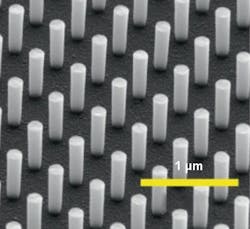Scientists can observe cells and biological samples in real-time, create more precise nanostructures, and even send long-distance communications… all thanks to ultrashort laser light pulses. Despite this progress, however, dispersion — “a fundamental difficulty” — must be overcome. And researchers at the Harvard John A. Paulson School of Engineering and Applied Sciences (SEAS) have found a way.
The SEAS-led research team has developed a nanopillar silicon coating that can counteract the effects of dispersion. Chromatic dispersion — different frequencies of light (red and blue, in particular) traveling at different velocities, which the researchers say causes “ultrashort laser pulses to elongate in time while propagating” — is a long-standing problem in ultrafast optical research.
This pulse-lengthening can basically render ultrafast pulses useless for many kinds of research. Existing solutions to this issue include adding dispersion-compensating components, but this approach increases the size and bulk of the optical system. The SEAS team’s new silicon coating avoids that.
Trial and error
The researchers tailored the dispersion of silicon nanopillar arrays “such that they temporally reshape pulses upon transmission using slow light effects and act as ultrashort laser pulse compressors.” According to the study, the silicon coatings “induce anomalous group delay dispersion” in the visible to near-IR region, at an approximately 800-nm wavelength over an 80-nm bandwidth.
The researchers found that the pillars can temporarily capture and hold red light before re-emitting it. The temporary hold essentially “allows the slower-moving blue light to catch up.” In the study, published in Nature Communications the silicon coating was tested via the shortening of laser pulses to “only a couple of quadrillionths of a second.”
Employing the same lithography tools used to build industrial semiconductors, the researchers note that it was relatively easy to “quickly apply these coatings to existing optical components and expand the applicability of femtosecond laser pulses.”
To demonstrate their findings, the researchers inserted a compressor directly in the path of a mode-locked Ti:sapphire oscillator and used second-harmonic frequency-resolved-optical-gating in which “laser pulses are split into two replicas and delayed with respect to each other.” They are then noncollinearly overlapped in a nonlinear crystal, the study notes, and “only when the pulses traverse the crystal simultaneously [is] second-harmonic radiation emitted toward the detector. Thus, recording the delay-dependent, second-harmonic spectrum yields a spectrogram from which the intensity and phase profiles of the laser pulses can be reconstructed.”
“Our coating counteracts the dispersive effects of transparent materials, acting as a speed bump for red light and averaging out the speed of each wavelength of light,” says study lead author Marcus Ossiander, a postdoctoral research fellow at SEAS. “Now, anyone can buy a lens, put the coating on, and use the lens without worrying about dispersion. This approach can be the basis for an array of anti- or non-dispersive optics.”
About the Author
Justine Murphy
Multimedia Director, Digital Infrastructure
Justine Murphy is the multimedia director for Endeavor Business Media's Digital Infrastructure Group. She is a multiple award-winning writer and editor with more 20 years of experience in newspaper publishing as well as public relations, marketing, and communications. For nearly 10 years, she has covered all facets of the optics and photonics industry as an editor, writer, web news anchor, and podcast host for an internationally reaching magazine publishing company. Her work has earned accolades from the New England Press Association as well as the SIIA/Jesse H. Neal Awards. She received a B.A. from the Massachusetts College of Liberal Arts.

